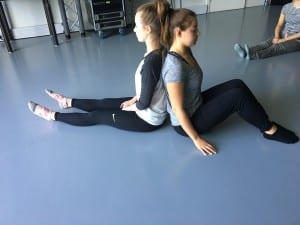“Touch is the mother of our senses” (Bannon and Holt, 218, 2012). It is a complex yet key sense used from such a young age, when we were younger we used it to explore our surroundings, the people we met and other things that got in our way. An issue with the idea of touch is that it can be seen as negative i.e. abuse and harm; this idea needs to been seen as a positive welcoming part of contact improvisation.
Throughout this technique you need to help and engage the trust of your peers, this is an important skill to have as “it brings a closeness and a sense of intimacy and community within the class” Bannon and Holt, 222, 2012). This is a key concept because if you do not trust your peers how are you going to perform in a contact improvisation jam, in which you have to make contact and do weight bearing movements.
Proprioception – “The unconscious perception of movement and spatial orientation arising from stimuli within the body itself.” (Dictionary.com, 2016)
The first touch exercise brought out my sensory knowledge, meaning that it made me more aware of what was going on within and around my body. When my partner put a hand between my shoulder blades and the other on the lower part of my back and pressed her hands away from each other I could sense my spine lengthening, it made me realise how much more I could possibly lift myself up out of my hips when performing. When my partner slowly moved her hands away I could still feel the connection she had made; this was using the concept of ‘not touching’, and proving that it has just the same amount of power as touching. During this same exercise we also focused on the idea of and over and under dancer, and how this is also a form of connecting; due to an injury I was unable to experience the full potential of this however I was able to feel and understand the main concept. For example, we used the breath to connect with each other, one pair in the group laughed, this was caused by one the under dancer laughing which then moves the chest of the other making her laugh. Throughout this whole exercise it made me think about my body awareness and made me realise where I had aches and pains.
How would you remake contact once it has been broken? At this stage we are likely to go to our ‘safe place’, for example the back to back exercise, due to injury I could not participate in this, so whilst I was observing I noticed that as soon as partners lost their contact with each other they would go back to the ‘safe place’- this being the starting position. Whilst watching this exercise I could see that some people struggled to keep communicating to their partners through the movements, and when this happens they tend to go back to their ‘safe place’ again. The second part to this task was to all sit in a circle and then everyone else could observe each other. This was interesting as you could start to see habitual movements creeping back in, to help with this you could try to move different body parts to help explore movement. Another thing I saw a lot of was when people ended up I to the over and under dancer was that the under dancer did not do a lot and expected the over dancer to move, however if the under dancer had moved it may have created something unique, that you may not have thought of before.
When I entered my first jam on Thursday night I did not know what to expect, especially because as a class we have only had two lessons on contact improvisation, so it was very new to most of us. We were told to get into a circle of trust, and just perform anything we had learnt so far from this module or anything in which we had learnt last year in our improvisation module, and there could be no less than two people in the centre of the circle. I was so nervous to go into the circle and jam, however if I had not have done it then I would never have overcome the fear of doing it. The best thing about this jam was that we were in a low lit studio so when I went into the circle I felt more comfortable and relaxed. The best way I felt to move into the jam was to walk in and either start dancing alone or go up to someone and help aid their performance, the music which was used throughout the jam helped as it relaxed you more instead of feeling like everyone could hear you breathing and moving around the space. When performing with a partner or multiple partners I felt like I was moving in more of a unique way and there were not many habitual movements I performed, however as soon as I was dancing alone I could feel myself fall back into them movements, and I also panicked and hesitated. When I stepped back to the edge of the circle it was really inspiring to watch other people move as it placed ideas into my head of what I could do the next time I went in and I can then experiment with their movements to fit with my own individual style.
Bibliography:
Bannon, Fiona; Holt, Duncan. (2012) Touch: Experience and knowledge, Journal of Dance & Somatic Practices Vol. 3. (pp. 215-227)
Dictionary.com. (2016). the definition of proprioception. [online] Available at: http://www.dictionary.com/browse/proprioception [Accessed 6 October 2016].
